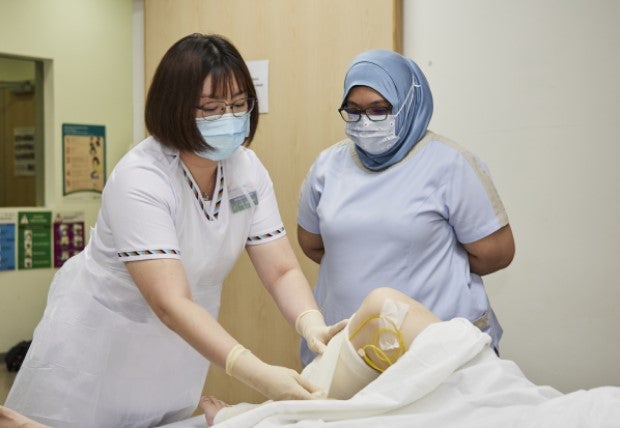
<< Ms Goh Wee Ting, SGH Nurse Clinician (Speciality Nursing, Vascular Wound Care), demonstrates to Ms Hafidah Saipollah how to wind the layers of compression bandaging at a correct pressure on a mock patient. Compression bandages prevent blood from pooling and fluid from collecting at the lower leg. >>
SGH-HNF partnership brings compression bandaging therapy into patients’ homes, ensuring wound care is not compromised by missed appointments.
Patients with hard-to-heal weeping sores, usually around the ankle, have to visit hospital nurses regularly to have their special dressings changed.
Known as compression dressings, the layers of bandages apply specific pressure on venous leg ulcers (VLUs) to improve blood flow, reduce swelling and promote healing. VLUs are caused by poor blood circulation in the leg veins, mostly occurring in those with diabetes, varicose veins or spider veins, and who are obese or elderly.

“There was a need to improve the access to graduated compression bandaging of patients with VLU in the community,” said Ms Fazila Aloweni (above), Senior Nurse Manager, Nursing Research, SGH.
A group of Singapore General Hospital (SGH) nurses then partnered Home Nursing Foundation (HNF) community nurses to offer compression bandaging service in the community, instead of at SGH, to provide greater convenience to patients while not jeopardising their care. Since November 2022, patients can have their compression bandages changed at home by nurses from HNF, a nonprofit home healthcare organisation.


Between January and April 2021, 15 HNF community nurses were taught the theory and practice of compression bandaging by SGH nurses who specialise in vascular and wound care such as Ms Goh Wee Ting (above left), SGH Nurse Clinician (Speciality Nursing, Vascular Wound Care). One of the HNF nurses, Ms Hafidah Saipollah (above right), Nurse Clinician, Wound, Ostomy and Continence Nursing, in turn taught another 10 of her HNF colleagues. This means that half of HNF’s 50 community nurses have been trained in compression bandaging.

<< During training, nurses check if they are applying the correct pressure. For healing to take place, two or four layers of compression bandages are applied at 20 to 30 millimetres of mercury (mmHg) for two layers or 30 to 40mmHg for four.>>
The nurses pass the competency test when they are able to perform pressure bandaging on at least 10 legs successfully. A comparison of 27 VLU patients managed at SGH clinics with 20 VLU patients cared for by HNF nurses — between May 2021 and August 2022 — showed no difference in their healing status at 12 weeks. “We plan to scale up this service with the training of our community nurses in compression therapy to benefit more venous leg ulcer patients,” said Ms Hafidah.
Patients with impaired or limited mobility, without dedicated caregivers or who are unable to travel to the hospital regularly are referred to HNF care. Even after the patients’ wound care is taken over by HNF, SGH nurses continue to monitor their conditions. The HNF nurses will alert their SGH counterparts if a patient’s condition has deteriorated.
Ensuring proper wound care is important to avoid severe infection and even hospitalisation. Patients might skip their hospital appointments to have their VLUs cleaned and bandaged if they find the weekly visits too troublesome, or are unable to arrange for a caregiver to take them to SGH.
“The partnership with HNF helps to drive compliance to treatment and, hence, better outcomes,” said Ms Fazila, adding that having some patients cared for in the community allows SGH acute care nurses to focus their attention on patients with more complex or severe conditions.
The SGH-HNF collaboration underscores the aims of the national Healthier SG initiative to prevent or delay the deterioration of health, improve quality of life of Singaporeans, while fostering community support for healthier lifestyles.
Get the latest updates about Singapore Health in your mailbox! Click here to subscribe.













 Get it on Google Play
Get it on Google Play